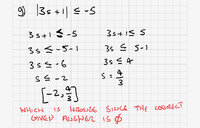Mathdabbler
New member
- Joined
- Sep 10, 2019
- Messages
- 11
Hello,
I am working through some inequalities of absolute numbers. I’ve worked through the one in the attachment and arrive at an answer of [-2,4/3]. However, the text book ( Schaum’s Intermediate Algebra) gives the answer as 0 ie an empty set. I do not see how they get that result. Can someone point me in the right direction? Am I making a fundamental error somewhere? I am getting most of the exercises correct, but there’s one or two like thIs that are problematic.
I am working through some inequalities of absolute numbers. I’ve worked through the one in the attachment and arrive at an answer of [-2,4/3]. However, the text book ( Schaum’s Intermediate Algebra) gives the answer as 0 ie an empty set. I do not see how they get that result. Can someone point me in the right direction? Am I making a fundamental error somewhere? I am getting most of the exercises correct, but there’s one or two like thIs that are problematic.

